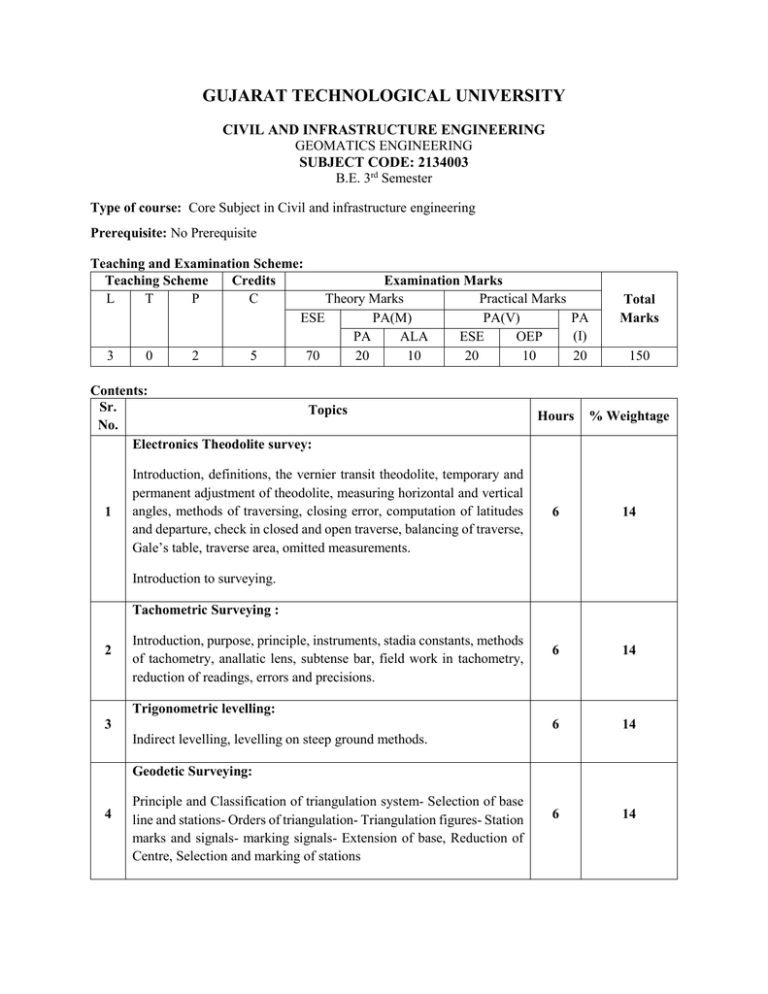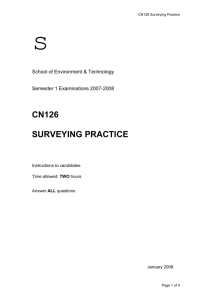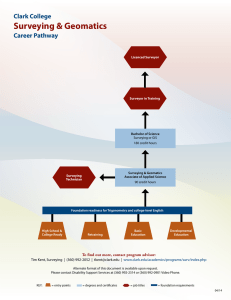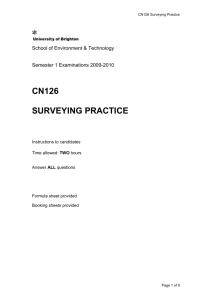2134003 - Gujarat Technological University
advertisement

GUJARAT TECHNOLOGICAL UNIVERSITY CIVIL AND INFRASTRUCTURE ENGINEERING GEOMATICS ENGINEERING SUBJECT CODE: 2134003 B.E. 3rd Semester Type of course: Core Subject in Civil and infrastructure engineering Prerequisite: No Prerequisite Teaching and Examination Scheme: Teaching Scheme Credits Examination Marks L T P C Theory Marks Practical Marks ESE PA(M) PA(V) PA (I) PA ALA ESE OEP 3 0 2 5 70 20 10 20 10 20 Contents: Sr. Topics No. Electronics Theodolite survey: 1 Introduction, definitions, the vernier transit theodolite, temporary and permanent adjustment of theodolite, measuring horizontal and vertical angles, methods of traversing, closing error, computation of latitudes and departure, check in closed and open traverse, balancing of traverse, Gale’s table, traverse area, omitted measurements. Total Marks 150 Hours % Weightage 6 14 6 14 6 14 6 14 Introduction to surveying. Tachometric Surveying : 2 Introduction, purpose, principle, instruments, stadia constants, methods of tachometry, anallatic lens, subtense bar, field work in tachometry, reduction of readings, errors and precisions. Trigonometric levelling: 3 Indirect levelling, levelling on steep ground methods. Geodetic Surveying: 4 Principle and Classification of triangulation system- Selection of base line and stations- Orders of triangulation- Triangulation figures- Station marks and signals- marking signals- Extension of base, Reduction of Centre, Selection and marking of stations Total Station Surveying: 5 Introduction, Electromagnetic distance measurement principles, horizontal & vertical angle measurements, setting up the total station, various field applications of total station surveying, data transfer mechanism and further process, advantages. 10 24 12 14 02 05 Modern Surveying Instruments: 6 Introduction, Electromagnetic distance measurement, Total station, Drone Survey (visual, LIDAR, multispectral & Thermal), DGPS survey, hydrographic survey. Setting Out Works: 7 Building Reference Books: T. P. Kanetkar and S. V. Kulkarni, Surveying and Levelling, Vol-I and Vol-II, Pune Vidyarthi Griha Prakshan, 1972. B. C. Punmia, A.K. Jain & A.K. Jain, Surveying, Vol-I and Vol-II, Laxmi Publication Pvt., 1996. T.M. Lillesand and R.W. Kiefer, Remote Sensing and Image Interpretation, John Wiley & Sons, 1994. G. W. Schofield, Engineering Surveying, Butterworth, Heinemann, New Delhi, 2001. G. Joseph, Fundamentals of Remote Sensing, Universities Press, 2003. Dr. K.R. Arora, Surveying Vol. I, II and III, Standard Book House. New Delhi S. K. Duggal, Surveying Vol. I and II, Tata Mcgraw Hill, New Delhi R. Agor, Surveying and Levelling, Khanna Publishers, New Delhi R. Agor, Advanced Surveying, Khanna Publishers, New Delhi Surveying and Levelling by N.N. Basak Roy, S.K., Fundamentals of Surveying, Prentice Hall India, New Delhi Subramanian, R., Surveying and Leveling, Oxford University Press, New Delhi Course Outcome: Conduct theodolite traverse surveys at identified site. Conduct trigonometrically leveling Set out simple circular and transition curves at given location Compute areas and volumes using standard rules and equipment’s such as plannimeter Give layout of foundations for buildings as per plan/drawing List of Experiments: Two point problem and three point problem Theodolite traversing and plotting of traverse by applying corrections in Gale’s traverse table Setting out simple circular curve by different methods Setting out combined curve (Transition - Circular – Transition) Setting out building foundations Computation of area of submergence and storage volume from contour maps for reservoir projects. Design based Problems/Open Ended Problems: 1. To find the capacity of reservoir 2. Identify location of recharge well for various sites Term Work: Term work shall be based on the following field projects conducted by students: 1. Total station survey project. 2. Theodolite traverse survey project. 3. Setting out of curve. ACTIVE LEARNING ASSIGNMENTS: Preparation of power-point slides, which include videos, animations, pictures, graphics for better understanding theory and practical work – The faculty will allocate chapters/ parts of chapters to groups of students so that the entire syllabus to be covered. The power-point slides should be put up on the web-site of the College/ Institute, along with the names of the students of the group, the name of the faculty, Department and College on the first slide. The best three works should submit to GTU.




